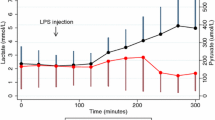Abstracts
Nitric oxide is very likely to play a role in physiopathological mechanisms of bacterial meningitis. As shown by in vitro studies, nitric oxide is toxic to endothelial cells, as well as to neurones, and thus may be responsible for neurological sequelae in bacterial meningitis. Increased level of nitric oxide can also inhibit mitochondrial respiration, enhancing anaerobic glycolysis. Twenty-seven children with documented bacterial meningitis, 73 with viral (mumps and enteroviral) meningitis, and 51 controls were studied. All children with bacterial meningitis were given cefotaxime (200 mg/kg per day). Glucose and protein concentrations and cerebrospinal fluid cell counts were determined routinely, as well as nitrite and nitrate levels. The levels of nitrite and nitrate in cerebrospinal fluid on admission were higher in patients with bacterial meningitis than in controls or in children with viral meningitis. In 10 patients, dexamethasone therapy (0.4 mg/kg every 12 h for 2 days) was started about 10 min before the first antibiotic dose. A significantly lower nitrite concentration was observed after 24–48 h of treatment compared with non-steroid-treated patients. Significant positive correlations between the nitrite and granulocyte counts and the protein concentration in cerebrospinal fluid were found in all patients with meningitis. Increased nitric oxide production in cerebrospinal fluid during the acute phase of bacterial meningitis may result from the inflammatory process and tissue injury. Dexamethasone administered before the first parenteral antibiotic dose seems to reduce nitric oxide production in the cerebrospinal fluid during bacterial meningitis.
Similar content being viewed by others
References
Bidri M, Becherel PA, LeGoff L, Piéroni L, Guillosson JJ, Debré P, Arock M. Involvement of cyclic nucleotides in the immunomodulatory effects of nitric oxide on murine mast cells. Biochem Biophys Res Commun 1995; 210:507.
Moncada S, Higgs EA. Molecular mechanisms and therapeutic strategies related to nitric oxide. FASEB J 1995; 9:1319.
Salvemini D, Misko PT, Masferrer MJ, Seibert K, Currie MG, Needleman P. Nitric oxide activates cyclooxygenase enzymes. Proc Natl Acad Sci U S A 1993; 90:7240.
Weinberg JB, Misukonis MA, Shami PJ, Mason SN, Sauls DL, Dittman WA, Wood ER, Smith GK, McDonald B, Bachus KE, Haney AF, Granger DL. Human mononuclear phagocyte inducible nitric oxide synthase (iNOS): analysis of iNOS mRNA, iNOS protein, biopterin, and nitric oxide production by blood monocytes and peritoneal macrophages. Blood 1995; 86:1184.
Di Mascio P, Dewez B, Garcia CRS. Ghost protein damage by peroxinitrite and its protection by melatonin. Braz J Med Biol Res 2000; 33:11.
Murohara T, Asahara T, Silver M, Bauters C, Masuda H, Kalka C, Kearney M, Chen D, Chen D, Symes JF, Fishman MC, Huang PL. Nitric oxide synthase modulates angiogenesis in response to tissue ischemia. J Clin Invest 1998; 101:2567.
Ziche M, Morbidelli L, Choudhuri R, Zang H-T, Donnini S, Granger HJ. Nitric oxide synthase lies downstream from vascular endothelial growth factor-induced but not basic fibroblast growth factor — induced angiogenesis. J Clin Invest 1997; 99:2625.
Austyn JM, Wood KJ. Cellular cytotoxicity. In: Austyn JM, Wood KJ, eds. Principles of cellular and molecular immunology. New York: Oxford University Press; 1994: 608.
Geng Y-J, Hansson GK, Holme E. Interferon γ and tumor necrosis factor synergize to induce nitric oxide production and inhibit mitochondrial respiration in vascular smooth muscle cells. Circ Res 1992; 71:1268.
Kornelisse RF, Hoekman K, Visser JJ, Suur MH, Hop WCJ, Neijens HJ, De Groot R. The role of nitric oxide in bacterial meningitis in children. J Infect Dis 1996; 174:120.
Turren J. Effect of recombinant human tumor necrosis factor-alpha on cerebral oxygen uptake, cerebrospinal fluid lactate, and cerebral blood flow in the rabbit: role of nitric oxide. J Clin Invest 1995; 95:1086.
Schaad UB, Lips U, Gnehm HE, Blumberg A, Heinzer I, Wedgwood J. Dexamethasone therapy for bacterial meningitis in children. Swiss Meningitis Study Group. Lancet 1993; 342:457.
Markiewicz Z, Śmigielska J. Determination of nitrite in serum. Sci Copybooks ATA Olszt Vet 1975; 5:169.
Tyszkiewicz I. Modification of nitrate determination in meat. Meat Economy 1986; 1:20.
Koedel U, Bernatowicz A, Paul R, Frei K, Fontana A, Pfister H-W. Experimental pneumococcal meningitis: cerebrovascular alterations, brain edema, and meningeal inflammation are linked to the production of nitric oxide. Ann Neurol 1995; 37:313.
Pfister H-W, Bernatowicz A, Ködel M. Nitric oxide production in bacterial meningitis. J Neurol Neurosurg Psychiatry 1995; 58:384.
Szychowska Z. Clinical observation of meningitis with special consideration of chosen endocrinal function. Qualifying thesis, Wroclaw Medical University, 1994.
Baydoun AR, Bogle G, Pearson JD, Mann GE. Selective inhibition by dexamethasone induction of NO synthase, but not of induction of L-arginine transport, in activated murine macrophage J774 cells. Br J Pharmacol 1993; 110:1401.
Author information
Authors and Affiliations
Rights and permissions
About this article
Cite this article
Murawska-Ciałowicz, E., Szychowska, Z. & Trębusiewicz, B. Nitric oxide production during bacterial and viral meningitis in children. Int J Clin Lab Res 30, 127–131 (2000). https://doi.org/10.1007/BF02874171
Received:
Accepted:
Issue Date:
DOI: https://doi.org/10.1007/BF02874171




